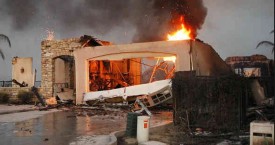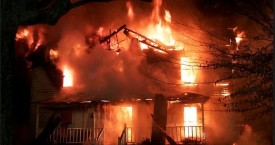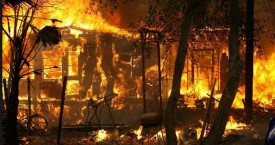LIFE SAFETY
Climate change is driving increased frequency and intensity of floods, droughts, fires and tropical wind storms. The need to engage in disaster risk preparedness to limit loss of life and property damage has never been more pressing.
Whilst no practical building material is truly fire or damageproof, resilient structures can help prevent tragedies when built with materials that are relatively resistant. Building with Kwik Build Panels provides more durable structures with increased resistance to fires, flood, wind storms and seismic events.
Wood framing contributes fuel and intensifies fires
Residential fires in the U.S. kill more than 2,500 people and incur over
$12 Billion in property damage annually.
Stop or Slow Fires Before they Escalate
A small investment today will harvest enormous future savings by protecting your assets and family’s safety. As fire related risks become an increasingly critical factor, do you ever wonder how well your walls will protect you?
Key is to construct buildings in which fire would progress slowly, allowing occupants plenty of time to escape. This is why materials are rated in respect to how long it would take a fire to affect a building’s structural integrity.
Kwik-Build Panels’ structural steel is not combustible. Steel tends to buckle under intense heat and does not contribute additional fuel to fires as wood does. Similarly, Expanded Polystyrene (EPS) melts rather than burns at very high temperatures and also does not contribute fuel to fires. By comparison, wood’s relatively low spontaneous ignition temperature of 482 °F, contributes fuel to fires, (too) frequently escalating small manageable fires to burning infernos.
For your enhanced protection, Kwik-Build Panels is a Class A fire rated system in accordance with ASTM D 1929 Section 8. The EPS is modified to reduce ‘flame spread’ and ‘smoke developed’. Vapors are non-toxic. In fact, less so than that of burning wood studs, commonly used in the building industry.
Expanded Polystyrene Approved for Flood-Prone Regions
Classified as a flood-resistant construction material, Expanded Polystyrene (EPS) is approved by the Federal Emergency Management Agency (FEMA) for flood prone areas. The capillary action of water does not penetrate EPS, due to its closed cell structure. In flood conditions, Kwik-Build Panels resist the ravages of water damage, protecting exterior wall enclosures as well as the building interior, which could otherwise include structural deterioration, rotting of building materials and eventually, mold infestations. In addition, the thermal insulation performance of EPS is unaffected by exposure to water or water vapor.
Following a flood situation, water-logged drywall can simply be cut off and replaced, over the unaffected walls constructed from Kwik-Build Panels. In other words, the entire structure is not condemned.
Wind Resistance
Based on Transverse Test Results of 136.3 pounds per square foot and in accordance with ‘Net Design Wind Pressure Chart’ ASCE 7-05 when calculating wind loads. Kwik-Build Panels qualifies for wind resistance of 170 miles per hour (mph).
Earthquake Protection
In seismic events, property damage is largely mitigated by reduced building mass and relative lightweight-to-strength ratio of building systems, compared to heavier building systems.
The combination of steel and Expanded Polystyrene (EPS) in Kwik-Build Panels, provides the 3 most important properties of earthquake resistance: strength, ductility (flexibility) and relative stiffness (stiffer structures deflect less in earthquake conditions). These elements are generally able to withstand severe sideways forces (racking and shear) without incurring significant damage, as long as the panels are well anchored to the foundation (per installation directions).
The exceptional ductility of steel’s capacity to resist tensile forces, coupled with the compression strength and resilience of the EPS provides absorption of building movement without transferring stress to the interior or exterior structural joints.
“Structural steel provides significantly better resilience, ductility and toughness
per unit-weight than concrete and masonry materials, in resisting seismic forces.”
In August 1993, 12 homes in Guam, that were built from a similar system as Kwik-Build Panels experienced an 8,1 earthquake. The only damage suffered were hairline cracks in the exterior stucco with no breaks in the drywall tape joints. Throughout the area high-rise structures were damaged, including 2 hotels and a number of bridges destroyed.
According to the Earthquake Engineering Department at UC Berkeley:
“In seismic resistant construction, the use of unnecessary building mass should be avoided.”
“Building a home in fire prone Cuyamaca region, the question was not “if” a devastating fire would ever break out again, but “when”. My research indicated that using Kwik-Build Panels would provide me with the best fire resistance, at the most reasonable cost. It also facilitated being my own builder. Panels were easy to use as long as you start out with an accurately measured slab. Winter hindered our progress, so that panels ended up sitting in snow through the winter undamaged.”
David Hogan, Home Owner



